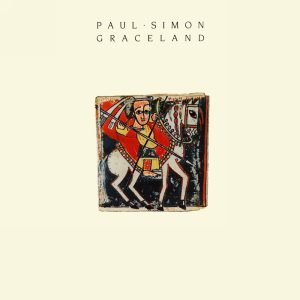When Paul Simon released Graceland in 1986, it wasn’t just another addition to his already illustrious discography; it was a seismic shift in his artistic trajectory. By that point, Simon had cemented his reputation as one-half of the legendary duo Simon & Garfunkel and as a solo artist celebrated for his poetic lyricism and introspective folk-rock melodies. But Graceland marked an adventurous departure, intertwining the rhythmic vitality of South African music with Simon’s penchant for vivid storytelling, creating a tapestry that resonated far beyond its sonic origins.
The album emerged during a tumultuous moment in the global music landscape. The 1980s had been defined by technological experimentation—synthesizers, drum machines, and glossy production dominated the charts. Against this backdrop, Graceland felt organic and vibrant, bridging worlds in a way that was both unexpected and deeply intentional. Its creation was rooted in Simon’s exploration of mbaqanga, isicathamiya, and other South African styles, genres he first encountered through a cassette tape of township jive. This influence collided with his American folk and pop sensibilities, crafting a hybrid that felt revolutionary but never exploitative.
Sonic Exploration

From its very first notes, Graceland announces itself as a sonic marvel, bursting with clarity, texture, and warmth. The album’s production, spearheaded by Paul Simon and engineer Roy Halee, is a masterclass in precision and vibrancy. Each track feels alive, as if the listener is sitting in the room with the musicians. The crispness of the recordings allows the intricate layers of instrumentation to shine through without overwhelming the vocals or lyrics. This balance is critical, as the album is as much about its storytelling as its musical brilliance.
Production Quality: A Global Studio
The production of Graceland mirrors its international influences. Simon recorded the album in a variety of studios, including locations in South Africa, Los Angeles, and London, creating a fluid exchange of ideas across borders. The result is a polished yet organic sound that emphasizes the communal nature of the project. Whether it’s the tight, interlocking guitar rhythms on “I Know What I Know” or the percussive drive of “Diamonds on the Soles of Her Shoes,” the production is meticulous without feeling over-engineered. The tonal clarity of each element invites repeated listening, offering new details with every play.
Musical Arrangements: Complex, Joyful, and Groundbreaking
The arrangements on Graceland are nothing short of dazzling. South African mbaqanga grooves form the backbone of many tracks, with their buoyant basslines and infectious guitar riffs creating a rhythmic momentum that drives the album forward. For example, “The Boy in the Bubble” juxtaposes the deep pulse of an accordion with a booming bass drum, while the title track, “Graceland,” blends a rolling guitar pattern with delicate vocal harmonies that evoke a sense of pilgrimage and longing.
The album also makes brilliant use of vocal textures. The contributions of South African groups like Ladysmith Black Mambazo lend a spiritual and celebratory quality, particularly on tracks like “Homeless” and “Diamonds on the Soles of Her Shoes.” Their harmonies, rooted in the isicathamiya tradition, add emotional depth and authenticity, making the album feel like a true collaboration rather than a surface-level appropriation.
Genre Elements: A Seamless Fusion
What makes Graceland so remarkable is its genre fluidity. At its core, the album is a fusion of American folk, pop, and rock with South African styles such as mbaqanga and isicathamiya. Yet it doesn’t stop there. Tracks like “You Can Call Me Al” incorporate jazz-like horn arrangements and Afro-pop rhythms, while “All Around the World or the Myth of Fingerprints” flirts with zydeco, thanks to the contributions of Los Lobos.
This genre-blending was groundbreaking for a mainstream album at the time, presenting a truly global sound without sacrificing coherence. Rather than feeling like a patchwork of disparate influences, Graceland achieves a unified aesthetic. It’s a musical dialogue where each style informs and enriches the other, breaking down perceived boundaries while celebrating the uniqueness of its individual parts.
Lyrical Analysis

Paul Simon’s lyrical prowess has always been a cornerstone of his artistry, and Graceland is no exception. Across the album’s 11 tracks, Simon crafts a narrative tapestry that is at once deeply personal and universally resonant. Drawing on themes of loss, redemption, identity, and connection, the lyrics of Graceland transcend the specificity of their cultural and geographical roots, offering listeners a window into Simon’s own emotional landscape while inviting broader interpretations.
Themes and Messages: Loss, Renewal, and Human Connection
At its heart, Graceland is an album about journeys—both literal and metaphorical. The title track, for instance, chronicles a pilgrimage to Elvis Presley’s Memphis estate but uses this road trip as a metaphor for searching for solace and understanding after personal upheaval. “Losing love is like a window in your heart / Everybody sees you’re blown apart,” Simon sings, encapsulating the ache of heartbreak while holding onto a thread of hope.
Throughout the album, there’s a recurring focus on the intersections of culture, identity, and shared humanity. Tracks like “The Boy in the Bubble” juxtapose images of modernity’s marvels and horrors—“These are the days of miracle and wonder / This is the long-distance call”—exploring how technology shapes our world and our relationships. Meanwhile, “Homeless” and “Diamonds on the Soles of Her Shoes” celebrate resilience and dignity in the face of adversity, with Simon’s lyrics often serving as a bridge between his observations and the voices of his South African collaborators.
Lyrical Depth: A Blend of the Literal and the Abstract
Simon’s lyrics on Graceland walk a fine line between the literal and the abstract. Many songs are rooted in storytelling, like the whimsical narrative of “You Can Call Me Al,” which balances humor with existential reflection. The lyrics describe an everyman character facing a midlife crisis, grappling with questions of self-worth and purpose. Yet Simon leaves space for interpretation, using surreal imagery—“A man walks down the street, it’s a street in a strange world”—to mirror the disorientation that often accompanies personal transformation.
Elsewhere, Simon leans into poetic abstraction. In “Gumboots,” he references fleeting moments of joy and companionship with lines like “I was walking down the street when I thought I heard this voice say / ‘Say, ain’t we walking down the same street together?’” The lyrics leave room for listeners to project their own experiences onto the song, a hallmark of Simon’s songwriting genius.
Emotional Impact: From Melancholy to Jubilation
What makes the lyrics of Graceland so impactful is their ability to evoke a wide range of emotions. On one hand, there’s the melancholy introspection of songs like “Graceland” and “Under African Skies,” which capture the weight of personal and historical struggles. On the other, tracks like “You Can Call Me Al” and “Crazy Love, Vol. II” exude a buoyant, almost jubilant energy, offering moments of levity and catharsis.
Perhaps the most profound emotional resonance comes from the interplay between the lyrics and the music. On “Homeless,” the sparse, haunting refrain sung by Ladysmith Black Mambazo amplifies the song’s themes of displacement and yearning. Conversely, the lively rhythms of “I Know What I Know” transform its bittersweet lyrics into a celebration of life’s unpredictable twists and turns.
Cohesion and Flow

One of Graceland’s most remarkable achievements lies in its cohesion. Despite drawing from a multitude of musical styles, collaborators, and cultural influences, the album feels unified—a testament to Paul Simon’s meticulous artistry and vision. Every track contributes to the overarching narrative of personal and artistic discovery, creating an album that functions as both a collection of individual masterpieces and a singular, immersive experience.
Track Progression: A Musical Pilgrimage
The sequencing of Graceland is both deliberate and intuitive, guiding listeners through peaks and valleys of emotion and energy. The album opens with “The Boy in the Bubble,” a track that immediately grabs attention with its accordion-driven rhythm and stark, thought-provoking lyrics. It sets the tone for the journey ahead: reflective, exploratory, and rich in texture. From there, the title track, “Graceland,” deepens the sense of introspection while maintaining the album’s rhythmic vitality, establishing a central motif of movement—both physical and emotional.
The midsection of the album brings a playful, celebratory energy with tracks like “I Know What I Know” and “You Can Call Me Al.” These songs serve as emotional reprieves, balancing the weightier themes of loss and redemption found in the more meditative moments. The inclusion of Ladysmith Black Mambazo on “Diamonds on the Soles of Her Shoes” and “Homeless” creates a spiritual and transcendent interlude, slowing the pace to allow for reflection.
The closing tracks, including “Under African Skies” and “All Around the World or the Myth of Fingerprints,” tie the album together with a sense of resolution. They echo earlier themes while adding new layers of complexity, ensuring that the album’s ending feels like the culmination of a journey rather than an abrupt conclusion. The flow is so natural that the listener never feels disoriented, despite the album’s stylistic diversity.
Thematic Consistency: A Singular Vision
Though Graceland incorporates influences from various genres and cultures, its themes and emotions are remarkably consistent. The album centers on ideas of connection—between people, cultures, and one’s past and future selves. Each track reflects this in its own way, whether through the poignant longing of “Graceland,” the communal harmonies of “Homeless,” or the existential musings of “You Can Call Me Al.”
Even the shifts in mood and tempo feel purposeful. The upbeat rhythms and jubilant melodies of tracks like “Crazy Love, Vol. II” do not undercut the album’s introspective moments; instead, they mirror the emotional highs and lows of Simon’s personal journey. Similarly, while the sonic palette shifts from South African township grooves to zydeco influences and American pop, the transitions are smooth, unified by Simon’s voice and the production’s attention to detail.
Standout Tracks and Moments
While every track on Graceland contributes to its overall brilliance, certain songs and moments rise to the surface as defining elements of the album’s legacy. These standout tracks showcase Paul Simon’s ability to blend innovation with emotional depth, while specific musical and lyrical choices encapsulate the album’s adventurous spirit.
Highlight Key Tracks
“Graceland”
The title track is a cornerstone of the album, not only for its narrative depth but also for its musical complexity. The song’s rolling guitar riff, inspired by South African kwela music, serves as a constant undercurrent, propelling the listener through Simon’s reflective lyrics about heartbreak and healing. The line “I’m going to Graceland, for reasons I cannot explain” captures the album’s essence—a search for meaning in the face of uncertainty. Its blend of personal and cultural discovery makes “Graceland” one of the most iconic tracks in Simon’s career.
“Diamonds on the Soles of Her Shoes”
This track radiates joy and sophistication, beginning with an a cappella introduction by Ladysmith Black Mambazo that sets a spiritual tone. As the music swells into a lush arrangement of bass, horns, and guitar, it becomes a celebration of resilience and beauty in unexpected places. The juxtaposition of the seemingly whimsical title with lyrics that hint at deeper social and economic commentary adds to its complexity.
“The Boy in the Bubble”
Opening the album with a stark accordion riff and a pulsating rhythm, this song combines ominous yet poetic lyrics with an infectious groove. Lines like “These are the days of miracle and wonder” reflect the duality of technological progress and human fragility. The song’s intricate layering of mbaqanga-inspired rhythms with Simon’s philosophical musings sets the tone for the album’s innovative fusion of sound and meaning.
“Homeless”
One of the most emotionally resonant tracks, “Homeless” is a testament to the power of collaboration. Featuring Ladysmith Black Mambazo’s hauntingly beautiful harmonies, the song juxtaposes its ethereal melodies with lyrics about displacement and longing. It’s a moment of stillness and introspection that highlights the cultural exchange at the heart of Graceland.
Memorable Moments
The Horn Break in “You Can Call Me Al”
The playful, dynamic horn section in “You Can Call Me Al” is one of the album’s most memorable musical moments. Paired with Simon’s surreal lyrics and the track’s infectious groove, the horns add an irresistible exuberance that captures the album’s celebratory energy.
The A Cappella Intro of “Diamonds on the Soles of Her Shoes”
The unaccompanied harmonies of Ladysmith Black Mambazo at the start of this track encapsulate the cultural exchange that defines Graceland. Their voices, raw and soulful, immediately draw the listener into a different musical world before the full band joins in.
The Accordion in “The Boy in the Bubble”
The driving accordion riff that opens the album is a bold and unexpected choice, signaling from the outset that this is not a conventional pop record. It sets the tone for the entire project, balancing a sense of grounded tradition with forward-looking experimentation.
The Closing Refrain of “Under African Skies”
The refrain of “Under African Skies,” with its rich vocal harmonies and poignant lyrics, provides one of the album’s most moving moments. The song feels like a hymn of gratitude and reverence, encapsulating Simon’s admiration for the cultures and musicians who inspired the album.
Artistic Contribution and Innovation

Place in Genre and Industry
When Graceland was released in 1986, it stood as a bold and unprecedented achievement within the music industry. At a time when the global music scene was dominated by electronic pop and hair metal, Paul Simon’s embrace of South African styles introduced mainstream audiences to the rich textures of mbaqanga, isicathamiya, and township jive. While artists like Peter Gabriel and David Byrne had already started incorporating elements of non-Western music into their work, Simon’s approach felt more immersive and collaborative.
The album’s influence extended far beyond its own genre. It became a defining moment for the burgeoning “world music” movement, a term that gained traction around this time. By blending these styles with Simon’s folk-pop sensibilities, Graceland redefined what global music could mean in the context of mainstream Western pop, paving the way for future cross-cultural collaborations. Its success—both commercially, with over 16 million copies sold, and critically, earning the Grammy Award for Album of the Year—cemented its place as a landmark in music history.
Innovation: A Fusion That Changed the Rules
Cultural Collaboration Without Precedent
The most innovative aspect of Graceland lies in its approach to cultural collaboration. Simon didn’t merely sample South African music or adapt it to fit his style; he worked directly with South African musicians, including Ladysmith Black Mambazo, the Boyoyo Boys, and others. This collaborative process created a true fusion of styles, with Simon’s songwriting weaving seamlessly into the intricate polyrhythms and melodies of South African traditions. At a time when apartheid still gripped South Africa, Simon’s decision to work with these artists, though controversial, also drew international attention to their extraordinary talent.
Revolutionary Genre Fusion
Simon’s ability to blend disparate genres into a cohesive whole was nothing short of revolutionary. Tracks like “You Can Call Me Al” and “Diamonds on the Soles of Her Shoes” fuse American folk and rock with mbaqanga’s rhythmic complexity, creating a sound that felt entirely new. Simon also drew on zydeco (as heard in “That Was Your Mother”), a cappella gospel harmonies, and even elements of electronic production. This genre fluidity expanded the possibilities for pop music, proving that it could be a vehicle for exploring and celebrating global influences.
Lyrical and Thematic Innovation
On a thematic level, Graceland broke ground by embedding personal narratives within a global context. The album explores universal themes of displacement, connection, and identity while remaining deeply introspective. Tracks like “Graceland” and “The Boy in the Bubble” juxtapose Simon’s personal struggles with larger sociopolitical commentary, offering a nuanced lens through which to view the intersections of the personal and the global.
Production Excellence
From a production standpoint, Graceland set a new standard for how cultural hybridity could be captured in the studio. Simon and co-producer Roy Halee preserved the authenticity of the South African performances while integrating them seamlessly into the Western pop framework. The album’s sonic clarity and balance were groundbreaking, ensuring that every voice, instrument, and rhythm could be distinctly appreciated.
Closing Thoughts

Paul Simon’s Graceland is an extraordinary achievement that continues to resonate nearly four decades after its release. Its strengths lie in its fearless innovation, masterful production, and ability to blend deeply personal storytelling with a celebration of global music traditions. By taking a creative risk during a critical juncture in his career, Simon not only revitalized his artistic vision but also expanded the boundaries of what pop music could achieve. The album’s fusion of American folk-rock with South African rhythms, harmonies, and instrumentation was groundbreaking in 1986, and it remains a touchstone for cross-cultural collaboration in music.
Strengths
Musical Innovation: The album’s seamless integration of diverse musical traditions set a new standard for genre fusion.
Cohesion and Vision: Despite its eclectic influences, Graceland maintains a unified narrative and emotional arc.
Lyrical Depth: Simon’s poetic and introspective lyrics add a layer of universality, making the album deeply relatable despite its specificity.
Cultural Impact: The project introduced South African music to a global audience, shining a light on the talent of its collaborators while sparking important (if contentious) conversations about cultural exchange and appropriation.
Weaknesses
While Graceland is rightly celebrated, it is not without its criticisms. The decision to record with South African artists during apartheid drew controversy, as it was seen by some as a violation of the cultural boycott against the regime. Though Simon maintained that the project was apolitical and sought to uplift the voices of South African musicians, the ethical complexities surrounding its creation remain a point of discussion. Additionally, some listeners may find the stylistic shifts between tracks slightly jarring, particularly when moving from African influences to the zydeco tones of “That Was Your Mother.”
Final Thoughts
Graceland is a landmark album, not just for Paul Simon but for popular music as a whole. It revitalized Simon’s career, introduced millions of listeners to the vibrancy of South African music, and demonstrated how art can bridge cultural divides. For listeners, the album offers a rich tapestry of sounds and stories that are as moving today as they were upon its release. It invites exploration and reflection, rewarding both casual and deep listening.
official Rating
We award Paul Simon’s Graceland with a 9 out of 10 rating. This 9/10 rating reflects Graceland’s extraordinary achievements and lasting impact. Its innovative approach to music-making, emotional depth, and cultural significance make it a masterpiece. However, the controversies surrounding its creation and the occasional stylistic inconsistencies prevent it from achieving perfect marks. Nevertheless, Graceland remains a defining moment in Paul Simon’s career and a transformative work in the world of music, standing as both a product of its time and a timeless piece of art.
